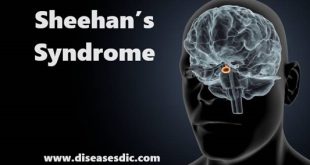Definition
Sneddon syndrome is a rare, progressive condition that affects blood vessels. It is primarily characterized by livedo reticularis (net-like patterns of discoloration on the skin) and neurological abnormalities. Symptoms may include transient ischemic attacks (mini-strokes) and strokes; headache; dizziness; high blood pressure; and heart disease. Reduced blood flow to the brain may cause reduced intellectual ability, memory loss, personality changes, and/or other neurological symptoms. The cause of Sneddon syndrome is often unknown, but it is sometimes associated with an autoimmune disease.
Most cases are sporadic but some familial cases with autosomal dominant inheritance have been reported. Some researchers separate Sneddon syndrome into two different types depending on whether an underlying cause has been identified (primary versus idiopathic), while others suggest a classification based on whether certain symptoms of autoimmune disease are present or not (aPL-positive versus aPL negative). Treatment usually involves anticoagulation (blood-thinning) with warfarin, and/or the use of other medications.
Classification of Sneddon Syndrome
Sneddon syndrome is classified as antiphospholipid negative (aPL-negative) or antiphospholipid positive (aPL-positive), based on the presence of any of 3 antiphospholipid antibodies: anticardiolipin, lupus anticoagulant, and anti-beta 2-glycoprotein 1.
Sneddon syndrome can also be classified as primary (idiopathic) or secondary to an identified thrombophilia or autoimmune disease, such as lupus erythematosus. It is also occasionally classified as a vasculitis.
Epidemiology
Incidence is estimated at four cases per million population per year, but the true incidence may be higher because some patients are not diagnosed. Although initially thought to have a genetic aetiology (one family cluster displayed autosomal dominant inheritance), further studies have failed to demonstrate any family history in most affected patients.
Sneddon Syndrome Pathophysiology
Pathophysiology of SS remains incompletely understood to date. The existence of aPL antibodies suggests that symptoms are secondary to thrombotic process. Vascular thrombosis and recanalization within skin and brain tissue support the pathophysiology of coagulopathy.
Although a basic thrombotic process may appear in SS, it is still not clear how it occurs in aPL-negative cases.Various abnormalities have been reported in isolated cases: activated protein C resistance, platelet aggregability, increased thromboglobulin levels, modifications of the ratio tissue plasminogen activator/inhibitor, familial deficiency in antithrombin III, and protein S deficiency. None of these abnormalities have been confirmed in large series of studies. Protein Z, a downregulator of coagulation and linked to an increased risk of arterial thrombosis, is significantly lowered in patients with aPL-negative SS. Heart valve abnormalities, either clinically audible or detected on echocardiogram, are frequently observed, and their total prevalence is similar in both groups. This raises the possibility that the embolic mechanism plays an important role in the occurrence of some neurologic and even skin manifestations of SS.
In some patients, no aPL or primary coagulation deficits are detected. Thus, the primary vasculopathy is considered as the pathophysiological change in SS. It is speculated that a nonvasculitic small and medium sized vessel arteriopathy causes both skin symptoms and cerebrovascular events. However, the type and origin of the arteriopathy is largely unknown. In some cases, the gene responsible for the arteriopathy may play a role. Besides, endothelial dysfunction may be secondary to acquired autoimmune or mediated by some unknown factors.
Symptoms
People with Sneddon syndrome may have signs and symptoms that include:
- Painless rash that looks like fish nets or the patterns found on some snakes. The rash is called livedo reticularis if it’s on your legs or arms and appears when you’re cold and goes away when you’re warmer. If the rash is on your trunk and buttocks and persists even if you’re warm, it’s called livedo racemosa.
- Headaches.
- Dizziness.
- Strokes and TIAs.
- Changes in your personality, and your ways of thinking and behaving.
- Kidney problems (rare).
The signs and symptoms don’t usually appear all at once. You may develop purplish or reddish skin colorings years before any type of neurological events happen. Or you might have issues with your eyes or headaches first.
Causes of Sneddon Syndrome
As stated, the exact cause of Sneddon Syndrome is still a matter of investigations and research regarding it is still ongoing. Researchers believe that majority of the cases of Sneddon Syndrome occur randomly without any reason but there are possible environmental, genetic, and immunological factors involved in development of Sneddon Syndrome.
In some cases there has been more than one family member diagnosed with Sneddon Syndrome supporting the possibility of this being a familial or inherited condition.
The symptoms of Sneddon Syndrome are caused due to increase in the number of cells in the walls of the affected arteries. This results in the arteries getting narrowed due to the cell buildup. Because of this, there is significant decrease in the blood flow.
The arteries may also get occluded and prevent blood from flowing smoothly resulting in some areas or tissues not getting enough blood causing them to get thrombosed.
In some cases, clumps of cells may break loose from the main artery and start to flow with the bloodstream and then get lodged in some artery blocking the blood flow to that artery resulting in tissue necrosis as a result of reduced blood supply due to Sneddon Syndrome.
Complications
Cardiovascular complications of Sneddon syndrome include:
- Mitral or aortic valvulopathy
- Libman-Sacks endocarditis
- Systolic labile hypertension.
Ophthalmological complications of Sneddon syndrome include:
- Optic disc microaneurysm
- Macular oedema
- Retinal artery branch obstruction.
Renal complications are rare:
- Impaired creatinine clearance
- Renal artery thrombosis.
Diagnosis
The examination of the condition is carried out through physical examinations. The doctor will examine the medical history as well as the symptoms of the individual. You need to go to a doctor immediately in the event of livedo racemosa (pattern of skin discolouration).
The most commonly used diagnostic methods for Sneddon syndrome are skin biopsy and genetic tests. The neurological symptoms such as unexplained stroke in young individuals will also be examined by the doctor so as to understand the root cause of the severe symptoms.
Apart from these methods, the individual will have to undergo the following:
- Blood tests Brain MRI which may reveal white matter changes, infarcts, microbleeds or atrophy
- A thorough cardiovascular evaluation
- Skin biopsy, which may reveal occlusion of arterioles by the proliferation of the inner lining
- Cerebral angiography, which is usually abnormal in up to 75% of patients
While conducting the blood tests to understand the symptoms, it will be used to examine the presence of the following:
- Lupus anticoagulant
- Antithrombin-III Protein C or protein S
- Circulating immune complexes
- Anti-nuclear (ana) and anti-double-stranded DNA autoantibodies
- Thrombocytopenia and leukopenia, which is low white cell count
- Vdrl
- Cryoglobulins
- Immunoglobulin igg and possibly IgM anti-cardiolipin antibodies, that is, the types of antiphospholipid antibodies, which may be positive in about 60% of cases
Angiography capillaries
Sneddon Syndrome Treatment
Therapeutic options for Sneddon syndrome are limited. Control of associated cardiovascular risk factors is important for either subset. The use of acetylsalicylic acid (ASA) and anticoagulation for aPL-associated disease is informed somewhat by experience with thrombotic complications in primary and lupus-associated aPL syndrome (see discussion in antiphosphlipid antibody syndrome).
Some advocate the use of similar therapies in non-aPL-antibody-associated Sneddon, but there is no strong supporting evidence for or against. Insufficient evidence exists to guide the use of antiplatelet agents or corticosteroids, although these are advocated by some. ASA 81mg would seem to be the best dose, but no data exists. While some suggest consideration of corticosteroid use, limited or no efficacy has been repeatedly described following the use of various immunotherapies, including corticosteroids, and their use without antithrombotic agents may be harmful.
Even anticoagulant therapy, for which a stronger rationale might be offered especially in aPL-antibody-positive patients, has not been proven to be of benefit. If warfarin therapy is contraindicated, antiplatelet therapy with ASA and clopidogrel has been suggested, again without any conclusive evidence. Thrombolytic agents and vasodilators have been used in the acute setting.
Optimal Therapeutic Approach for this Disease
As outlined in the previous section, therapy for this syndrome is limited, focusing on the use of antiplatelet agents or corticosteroids.
Patient Management
The dermatologist’s role in patients with Sneddon syndrome is primarily to consider the diagnosis in patients with persistent or extensive livedo reticularis or racemosa, and to evaluate for hypertension or possible early warning signs of mild TIA or CVA symptoms. Once the diagnosis is strongly suspected or established, care and counseling would seem to be the responsibility of the primary care physician or neurologist.
Unusual Clinical Scenarios to Consider in Patient Management
There is much to learn about the pathophysiology of Sneddon syndrome and of aPL syndrome, and there currently appears to be no clear direction for new avenues of therapeutic intervention.
 Diseases Treatments Dictionary This is complete solution to read all diseases treatments Which covers Prevention, Causes, Symptoms, Medical Terms, Drugs, Prescription, Natural Remedies with cures and Treatments. Most of the common diseases were listed in names, split with categories.
Diseases Treatments Dictionary This is complete solution to read all diseases treatments Which covers Prevention, Causes, Symptoms, Medical Terms, Drugs, Prescription, Natural Remedies with cures and Treatments. Most of the common diseases were listed in names, split with categories.







